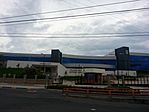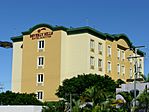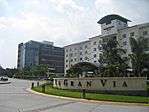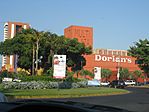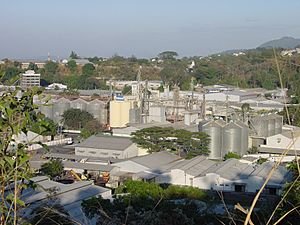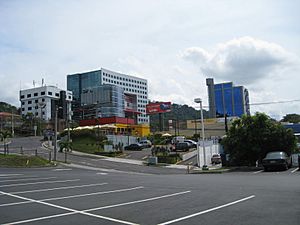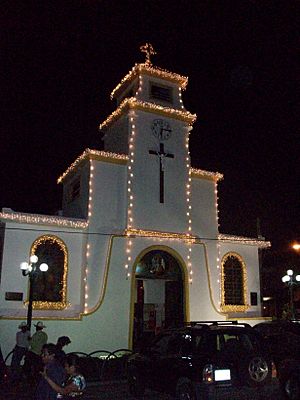Antiguo Cuscatlán facts for kids
Quick facts for kids
Antiguo Cuscatlán
|
||
|---|---|---|
|
Municipality
|
||
|
Images from top, left to right: Torre Avante, Palacio Municipal de Antiguo Cuscatlán, Beverly Hills Hotel, Iglesia de Los Santos Niños Inocentes, Marriot Hotel and Banco Promerica, Multiplaza Mall San Salvador.
|
||
|
||
| Nickname(s):
Antiguo
|
||
| Country | ||
| Department | La Libertad Department | |
| Metro | San Salvador Metropolitan Area | |
| Establishment as Town | 30 March 1971 | |
| Establishment as City | 19 February 1987 | |
| Government | ||
| • Type | Democratic Republic | |
| Area | ||
| • Municipality | 19.41 km2 (7.49 sq mi) | |
| Elevation | 849 m (2,926.5 ft) | |
| Population
(2020)
|
||
| • Municipality | 47,956 | |
| • Density | 2,470.7/km2 (6,403/sq mi) | |
| • Urban | 47,956 | |
| Demonym(s) | Cuscatleco | |
| Time zone | UTC−6 (Central Standard Time) | |
| SV-LI |
CP 1502
|
|
| Area code(s) | + 503 | |
| Website | www.antiguocuscatlan.gob.sv | |
Antiguo Cuscatlán is a city in the La Libertad area of El Salvador. People sometimes call it "Antiguo" for short. It's located southwest of San Salvador and close to Santa Tecla. In 2020, about 47,956 people lived there.
The name Antiguo Cuscatlán means "Old Jeweled City." Antiguo is Spanish for "old," and Cuscatlán means "jeweled city" in the Nahuat language. This city was once the capital of the Pipil (also known as Cuzcatecs) before the Spanish arrived.
The older part of the city is at the bottom of the La Cordillera del Bálsamo mountains. The city then spreads out towards these mountains in the south and towards the San Salvador Volcano in the north. Antiguo Cuscatlán is part of the larger San Salvador metro area. Because of this, people sometimes think it's part of San Salvador itself.
Contents
History
According to old Pipil writings, Antiguo Cuscatlán was founded in 1054. It was called Cuzcatlan back then, which means "place of jewels." It was started by Topiltzin Atzil, who was the last king of Tula of Anahuac. It was a big city with about ten thousand people living there. Another twelve thousand people lived in straw huts around a sacred lake. This city was the capital of a larger kingdom called Cuzcatlan.
On June 17, 1524, Spanish explorers led by Pedro de Alvarado arrived at Cuscatlan. They had many soldiers and slaves ready to attack the kingdom. Even though the local people fought back, the Spanish won. They made the city part of the Spanish empire.
After this, Antiguo Cuscatlán became less important. It was just one of many towns in the country, which was mainly used for its natural resources by the Spanish. After Central America became independent, San Salvador grew much bigger and more important. Antiguo Cuscatlán became just a local capital.
Today, Antiguo Cuscatlán has become very important again. It is home to many major businesses, shopping centers, and even the largest U.S. Embassy in the region.
Economy
Most people in Antiguo Cuscatlán live in the city center. It is one of the most developed cities in El Salvador. However, some people still live in rural areas to the south, where the Cordillera del Balsamo mountains are.
The city has three main industrial areas: Santa Elena, Plan de La Laguna, and Merliot. In these areas, you can find factories that make food, plastics, metal, clothes, and chemicals. There are also places for tourists to visit, like the Basilica of Guadalupe and the Botanical Garden of Plan de la Laguna. In the mid-2010s, one of the biggest business centers in Central America opened here. This building shows how modern architecture and business are growing in the country.
Plan de la Laguna Industrial Zone
South of the city is the "Plan de La Laguna" Industrial Zone. Many factories are located here. Some of these companies make candy, plastic products, and flour for food. There are also companies that make animal feed. Many of these companies work together through an organization called Asevilla. This industrial zone is known for being well-organized. To help protect nature, the southern side of the Industrial Zone is next to the Plan de La Laguna Botanical Garden. This garden also has a plant nursery and is home to thousands of different plant types.
Santa Elena
Santa Elena is the main neighborhood in Antiguo Cuscatlán. It covers about 65% of the city. This area is home to one of the world's largest American Embassies. The Embassies of Malta and Belize are also located here.
Business
Santa Elena has many businesses. A very modern business center called Edificio Avante is located here. It is next to the Beverly Hills Hotel. Other business centers include Edificio Comercial and Edificio Valencia.
Botanical Garden (Jardin Botanico Plan de la Laguna)
The La Laguna Botanical Garden is located south of Antiguo Cuscatlán. It covers an area of 30 blocks. About 19 blocks are a protected forest. Another 4.6 blocks are open to the public. This public area has 32 sections with over 3,500 types of plants from all over the world. It also has a performance area, a café, and games for children. The garden is a great place for learning, science, and fun.
This garden is fairly new. The first German families who came to this area started dairy farms, cattle ranches, and coffee farms. They settled in the mountains near what is now Plan de La Laguna. The Deininger family brought trees and plants from around the world to their home garden, and these plants grew very large.
Over time, as the area became more developed, the Deininger family wanted to protect the wooded area. So, they supported the idea of creating the La Laguna Botanical Garden. It opened on December 22, 1978. Since then, about 24,000 students visit it every year.
The garden has a special collection of dried plants called a herbarium. It also has a computer database and a library focused on plant identification. The staff often work with plant experts from other countries to help identify plants found in El Salvador.
Geography
Antiguo Cuscatlán is part of the Nueva San Salvador District in the La Libertad department. It shares borders with San Salvador to the north and east, San Marcos to the east, Nuevo Cuscatlan to the south, and Nueva San Salvador to the west.
Soils
The soil types in Antiguo Cuscatlán include volcanic soil and reddish clay. These soils are formed from volcanic ash and lava.
Hydrography
The main river in the area is called the Chavez or Peche River. It starts about 2.5 kilometers south of Antiguo Cuscatlán where two small streams meet. The river flows for about 2 kilometers within the city's area.
Terrain
There are two mountains in the area: The Horse and El Rosario.
- The Horse mountain is about 3 kilometers southwest of Antiguo Cuscatlán. It is about 1032 meters (3385 feet) high.
- El Rosario mountain is about 1.4 kilometers south of Antiguo Cuscatlán. It is about 1025 meters high.
Climate
Antiguo Cuscatlán gets between 1,800 and 2,200 millimeters of rain each year. Because it is high up (about 1032 meters or 3385 feet), it has a cooler climate compared to the rest of the San Salvador Metropolitan Area (AMSS).
The warmest months are March, April, and May, with average high temperatures around 30°C. The coolest months are November, December, January, and February. During these months, the average high is about 28°C, and the average low is around 16°C. The lowest temperature ever recorded was 6°C in February and March 2010 during a cold spell.
| Climate data for Antiguo Cuscatlan | |||||||||||||
|---|---|---|---|---|---|---|---|---|---|---|---|---|---|
| Month | Jan | Feb | Mar | Apr | May | Jun | Jul | Aug | Sep | Oct | Nov | Dec | Year |
| Mean daily maximum °C (°F) | 29.3 (84.7) |
29.1 (84.4) |
30.0 (86.0) |
31.0 (87.8) |
30.8 (87.4) |
29.5 (85.1) |
30.1 (86.2) |
29.0 (84.2) |
28.0 (82.4) |
28.1 (82.6) |
27.0 (80.6) |
26.6 (79.9) |
26.0 (78.8) |
| Daily mean °C (°F) | 22.2 (72.0) |
22.8 (73.0) |
23.4 (74.1) |
24.5 (76.1) |
24.2 (75.6) |
23.3 (73.9) |
23.3 (73.9) |
23.1 (73.6) |
22.8 (73.0) |
22.4 (72.3) |
20.5 (68.9) |
21.4 (70.5) |
22.4 (72.3) |
| Mean daily minimum °C (°F) | 15.9 (60.6) |
15.3 (59.5) |
16.7 (62.1) |
17.0 (62.6) |
19.0 (66.2) |
19.6 (67.3) |
19.1 (66.4) |
17.3 (63.1) |
17.4 (63.3) |
16.0 (60.8) |
15.4 (59.7) |
14.0 (57.2) |
15.6 (60.1) |
| Average precipitation mm (inches) | 5.0 (0.20) |
2.0 (0.08) |
9.0 (0.35) |
36.0 (1.42) |
152.0 (5.98) |
292.0 (11.50) |
316.0 (12.44) |
311.0 (12.24) |
348.0 (13.70) |
217.0 (8.54) |
36.0 (1.42) |
10.0 (0.39) |
1,734 (68.3) |
| Source: worldweather.org; | |||||||||||||
Education
Antiguo Cuscatlán has many schools, both private and public. Some of the private schools include the German School of San Salvador, Colegio Americano, Colegio San Francisco, and Colegio Augusto Walte. Public schools like Centro Escolar Walter Thilo Deininger are also in the city.
The city is also home to several universities. These include José Simeón Cañas Central American University, José Matías Delgado University, Universidad Albert Einstein, and Universidad Don Bosco.
Culture
Antiguo Cuscatlán celebrates various festivals. One popular event is the Corn Festival, which takes place in July or August. On December 12, people celebrate in honor of Our Lady of Guadalupe at the Basilica of Our Lady of Guadalupe. The main city celebrations are on December 28, honoring the "Holy Innocents Children" at the Parish Church in the city center.
Festivities
The main celebrations in Antiguo Cuscatlán are dedicated to the Holy Innocents Children. They happen every year on December 28. This festival started in the 1500s, during the time when Spain ruled the area. It was a very grand celebration.
The Holy Innocents are honored as martyrs who died for Christ. They are sometimes called "Flower of the Martyrs." Saint Augustine described them as young buds destroyed by persecution before they could fully bloom.
Religion
In Antiguo Cuscatlán, there are four Catholic churches and ten Evangelic (Protestant) churches. The most important religious holiday is on December 28, celebrating the Holy Innocents Children.
This festival has been celebrated in the town since the colonial era. The Roman Catholic Church has celebrated it since the 5th century. Today, the city organizes many religious, cultural, artistic, and fun activities for the festival.
Gallery
See also
 In Spanish: Antiguo Cuscatlán para niños
In Spanish: Antiguo Cuscatlán para niños



